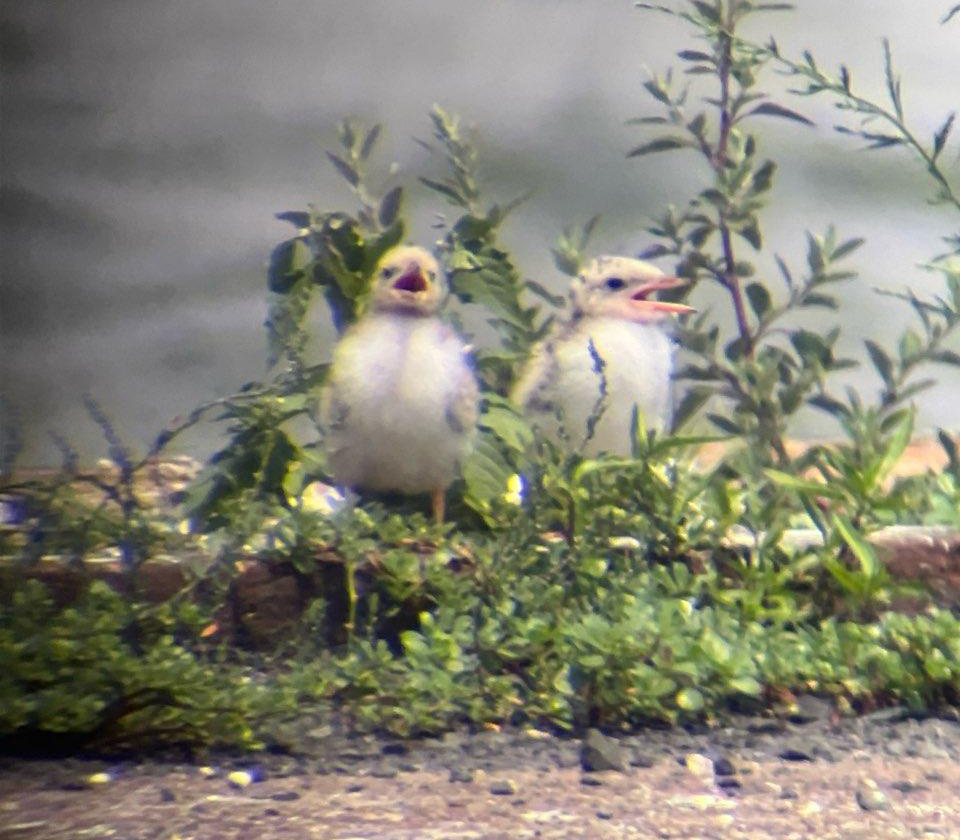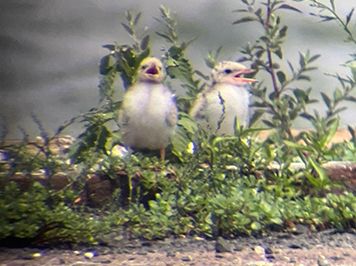Shipyard Associates agrees to remove deterrents and create 500 foot buffer on Pier 11
Some terns are now nesting at Union Dry Dock and Pier 12; two eggs just hatched on Pier 11

Two Common Tern fledglings at the end of Pier 11 in 2023.
FBW | June 13, 2024 updated June 18
Jeffrey Train, known as “Mr. Train,” as he leads birding walks in Hoboken, has observed a colony of Common Terns mating, nesting and raising their fledglings for the past seven years on a Hoboken pier. Common Terns are migratory birds that fly as far south as Argentina and Chile. In the spring, they return to Atlantic coastal areas in the U.S. and Canada. “These beautiful birds, who swoop and dive around the city’s piers,” Mr. Train remarks, “capture the attention of nature lovers and tourists alike.”
Last year, Mr. Train identified 50 terns and at least a dozen nests on this pier, known as Pier 11, just south of the Shipyard Marina at Hoboken’s north waterfront. The return of the terns this year, however, has spelled disaster.
On May 1, as the terns found their way back to Pier 11, they were thwarted by deterrents such as wire, reflective streamers, mesh netting and invisible string that had been installed several weeks earlier. Shipyard Associates, the pier’s owner, hired Bird Solutions to erect these devices, thinking that the terns would relocate elsewhere. They underestimated, however, the fidelity of these birds to return to this same spot where they had colonized for the past seven years.
A number of terns found their way back to the pier despite the deterrents. On May 30th, a tern was injured in the netting and later died. A nest of eggs, called a clutch, was also lost. According to Mr. Train and other local birders, any interference with a nesting colony is a violation of the federal Migratory Bird Treaty Act of 1918.
The attempt to expel the terns came after Shipyard Associates leased Pier 11 to Weeks Marine. Weeks applied for a zoning permit to install two trailers and to moor a construction barge on Pier 11 to be used in conjunction with its work on the Hudson River Gateway Tunnel. On May 8, 2024, the City of Hoboken issued the contractor a permit.
Mr. Train said the recent actions have seriously degraded the colony. On June 10, he counted just seven birds and three to four nests on Pier 11. Fortunately, he and other birders successfully thwarted plans by Shipyard Associates to power-wash the pier, after pointing out the prohibitions of the Migratory Bird Treaty Act.
On June 12, the Fund for a Better Waterfront and Mr. Train wrote to the Mayor and Council requesting the revocation of the zoning permit. Mayor Bhalla wrote back to Mr. Train stating that the City was working with Shipyard Associates and other parties to ensure that the birds are protected. Weeks Marine will locate its trailers and barge a safe distance of 500 feet from the terns. Shipyard Associates will work with an experienced bird monitor to remove the remaining deterrents.
The deterrents, however, have caused some terns to relocate to Pier 12, just north of Pier 11, also owned by Shipyard Associates, and to the north pier at Union Dry Dock, where NY Waterway is scheduled to install bumper piles beginning in July. So additional protections will now be required on these piers as well. On June 17, two tern eggs on Pier 11 hatched.
From May through July, terns lay a clutch of eggs (usually three). For three to four weeks, both sexes share incubation duties. Once the eggs hatch, the young will fledge for another four weeks. So their nesting season on Hoboken piers will continue through August, perhaps into September.
In flight, Common Terns are recognizable by their angular wings, red bills and black caps. They are able to dive toward the water picking off fish just below the surface. They are social birds, foraging in groups and nesting on the ground. Terns are long-lived birds but are declining in numbers due to human activities, including habitat loss and pollution.
The return of the terns to Pier 11 on the Hudson River, however, is a testament to the revival of the Hudson River ecosystem which in the 1900s had become heavily polluted and devoid of life. Many species of fish and aquatic life have returned to the river and are thus able to provide sustenance to shore birds such as the terns.
Mr. Train has proposed working with biologists, the NJDEP, the City and other parties to create a floating dock for the 2025 nesting season. Such a structure has worked successfully in Maryland and elsewhere.
Related Links
Discover Your Waterfront, Sunday June 16th, 9 AM – 12 PM
The Weehawken and Hoboken Coves provide opportunities for ecosystem restoration
Noelle Thurlow says Hoboken Cove is prime candidate for habitat restoration
Humpback whale swims up a cleaner, more hospitable Hudson River
A Plan for the Hoboken Waterfront


